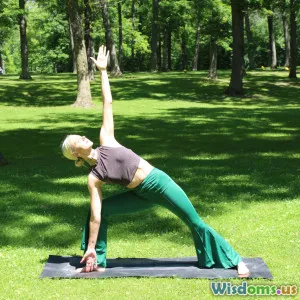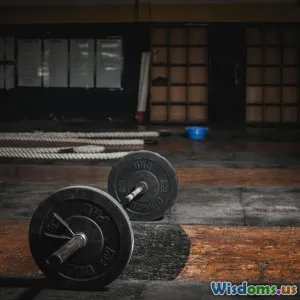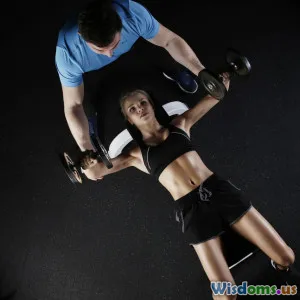
How to Build a Full Body Strength Routine with Zero Gym Equipment
8 min read Master a full body strength routine with no gym equipment using effective bodyweight exercises and expert tips. (0 Reviews)
How to Build a Full Body Strength Routine with Zero Gym Equipment
Building strength is often associated with clanging weights and complex machinery, yet some of the most effective workouts require nothing more than your own body and determination. In fact, the best gym for full body strength training might just be your living room, park, or even your office.
Introduction
Suspense lies in simplicity. If you’ve always felt tethered to gym memberships or fancy equipment to build muscle, prepare to rethink your approach. With science-backed bodyweight exercises and structured routines, zero equipment doesn’t mean zero progress. From growing functional strength to enhancing endurance, a no-equipment regimen has immense benefits including convenience, cost-efficiency, and comprehensive muscle engagement.
Why Choose a No-Equipment Full Body Routine?
1. Accessibility
No gym, no sweat. Anywhere can be transformed into your personal strength zone — be it a hotel room during travel, your morning backyard, or a quiet corner at home.
2. Functional Strength
Bodyweight exercises often require engaging core muscles and stabilize different joints. This functional strength aids everyday movements more than isolated gym machines might.
3. Injury Prevention and Progressive Loading
With guided progression, these exercises strengthen connective tissues and joints, building resilience without the sudden strain some heavy lifting might produce.
Key Principles for Building Your Routine
Focus on Compound Movements
Exercises like push-ups, squats, and lunges engage multiple muscle groups simultaneously — essential for full body development.
Incorporate Progressive Overload
Just as in weight training, you must challenge your muscles progressively. Increase reps, sets, or reduce rest times to continually grow stronger.
Prioritize Recovery
Strength gains happen in recovery. Allow at least 48 hours for muscle groups before targeting them intensely again.
Maintain Proper Form
In bodyweight training, form is everything. Incorrect alignment not only decreases effectiveness but increases risk of injury.
Bodyweight Exercises to Build Strength
Upper Body
- Push-Ups: Targets chest, shoulders, triceps, and core stabilization.
- Variations: Standard, wide grip, close grip, plyometric, or decline push-ups.
- Triceps Dips (using a chair or bench): Focus on triceps and shoulder stability.
- Plank to Push-Up Position Transition: Improves shoulder strength and core endurance.
Lower Body
- Bodyweight Squats: Foundational for your quads, hamstrings, glutes.
- Increase difficulty by performing jump squats or single-leg pistol squats.
- Lunges: Effective for building unilateral leg strength and balance.
- Glute Bridges: Strengthens the posterior chain including lower back and glutes.
Core
- Planks and Side Planks: Enhance deep core muscles and improve spinal alignment.
- Leg Raises: Target the lower abdominal muscles.
- Bicycle Crunches: Engage obliques and upper abs.
Sample Full Body Routine Structure
| Exercise | Sets | Reps | Rest |
|---|---|---|---|
| Push-Ups | 3 | 12-15 | 60 seconds |
| Bodyweight Squats | 3 | 15-20 | 60 seconds |
| Lunges (each leg) | 3 | 12 | 60 seconds |
| Plank | 3 | 30-45 sec | 45 seconds |
| Glute Bridges | 3 | 15-20 | 45 seconds |
| Bicycle Crunches | 3 | 20 | 45 seconds |
Example Weekly Schedule
- Monday: Strength routine
- Tuesday: Active recovery (walking, stretching)
- Wednesday: Repeat strength routine
- Thursday: Rest or yoga
- Friday: Strength routine
- Weekend: Light cardio or rest
The Science Behind Bodyweight Strength Training
Scientific studies support the substantial benefits of bodyweight resistance training. A 2017 study in the Journal of Sports Sciences noted improvements in muscle endurance and strength similar to traditional weight-training but with less risk of overuse injuries. Moreover, core stability exercises reduce lower back pain, shown in research published in Spine (2019).
Real-World Success Stories
Yoga instructor Rachel shares, “Switching to bodyweight routines gave me not just strength but mobility I’d never imagined. All without a gym membership or heavy machines.” Army veteran and trainer Mike states, “I rely entirely on bodyweight exercises during deployments — your body truly is the best tool.”
Tips for Staying Motivated and Avoiding Plateaus
- Track your workouts and progress with apps or a journal; seeing improvement is a powerful motivator.
- Change exercise variations every 4–6 weeks to challenge muscles in new ways.
- Join online communities or take part in virtual challenges to boost accountability.
Conclusion
Building a full body strength routine without equipment isn’t just feasible but highly practical and effective. By focusing on compound movements, progressing methodically, and prioritizing recovery and form, you can create a sustainable and impactful workout plan that fits any lifestyle. No gym, no excuses — just the drive to harness your body’s incredible capabilities.
Embrace simplicity as your secret weapon and watch your strength soar!
References:
- Schoenfeld, B. J. (2010). The mechanisms of muscle hypertrophy and their application to resistance training. Journal of Strength and Conditioning Research.
- Sekhon, M., Holtzman, D., & Snodgrass, S. (2017). Muscle activation levels during bodyweight exercises: a study in resistance training. Journal of Sports Sciences.
- Smith, E., et al. (2019). The impact of core stability exercises on lower back pain: A randomized controlled trial. Spine.
Rate the Post
User Reviews
Popular Posts


















